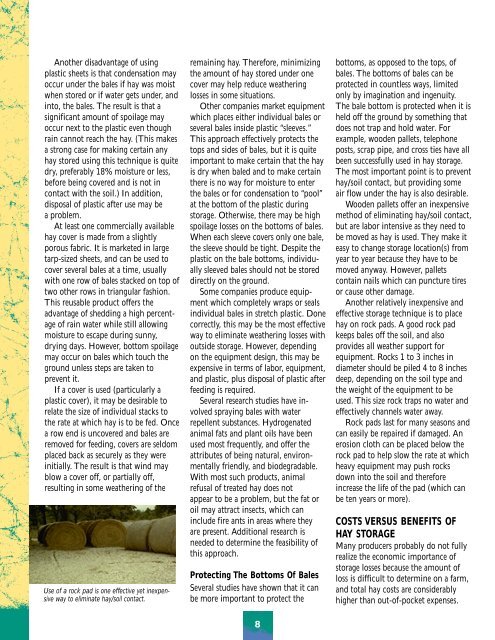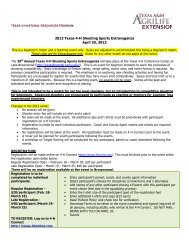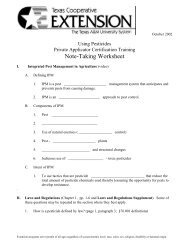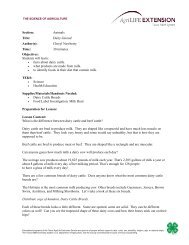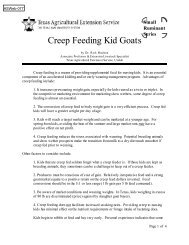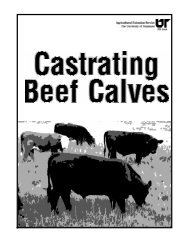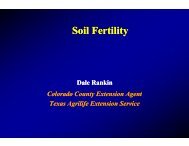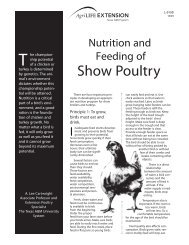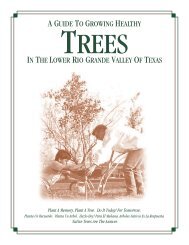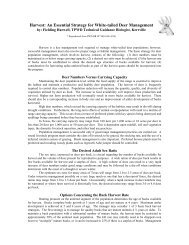Minimizing Losses in Hay Storage and Feeding - MSUcares
Minimizing Losses in Hay Storage and Feeding - MSUcares
Minimizing Losses in Hay Storage and Feeding - MSUcares
- No tags were found...
You also want an ePaper? Increase the reach of your titles
YUMPU automatically turns print PDFs into web optimized ePapers that Google loves.
Another disadvantage of us<strong>in</strong>gplastic sheets is that condensation mayoccur under the bales if hay was moistwhen stored or if water gets under, <strong>and</strong><strong>in</strong>to, the bales. The result is that asignificant amount of spoilage mayoccur next to the plastic even thoughra<strong>in</strong> cannot reach the hay. (This makesa strong case for mak<strong>in</strong>g certa<strong>in</strong> anyhay stored us<strong>in</strong>g this technique is quitedry, preferably 18% moisture or less,before be<strong>in</strong>g covered <strong>and</strong> is not <strong>in</strong>contact with the soil.) In addition,disposal of plastic after use may bea problem.At least one commercially availablehay cover is made from a slightlyporous fabric. It is marketed <strong>in</strong> largetarp-sized sheets, <strong>and</strong> can be used tocover several bales at a time, usuallywith one row of bales stacked on top oftwo other rows <strong>in</strong> triangular fashion.This reusable product offers theadvantage of shedd<strong>in</strong>g a high percentageof ra<strong>in</strong> water while still allow<strong>in</strong>gmoisture to escape dur<strong>in</strong>g sunny,dry<strong>in</strong>g days. However, bottom spoilagemay occur on bales which touch theground unless steps are taken toprevent it.If a cover is used (particularly aplastic cover), it may be desirable torelate the size of <strong>in</strong>dividual stacks tothe rate at which hay is to be fed. Oncea row end is uncovered <strong>and</strong> bales areremoved for feed<strong>in</strong>g, covers are seldomplaced back as securely as they were<strong>in</strong>itially. The result is that w<strong>in</strong>d mayblow a cover off, or partially off,result<strong>in</strong>g <strong>in</strong> some weather<strong>in</strong>g of theUse of a rock pad is one effective yet <strong>in</strong>expensiveway to elim<strong>in</strong>ate hay/soil contact.rema<strong>in</strong><strong>in</strong>g hay. Therefore, m<strong>in</strong>imiz<strong>in</strong>gthe amount of hay stored under onecover may help reduce weather<strong>in</strong>glosses <strong>in</strong> some situations.Other companies market equipmentwhich places either <strong>in</strong>dividual bales orseveral bales <strong>in</strong>side plastic “sleeves.”This approach effectively protects thetops <strong>and</strong> sides of bales, but it is quiteimportant to make certa<strong>in</strong> that the hayis dry when baled <strong>and</strong> to make certa<strong>in</strong>there is no way for moisture to enterthe bales or for condensation to “pool”at the bottom of the plastic dur<strong>in</strong>gstorage. Otherwise, there may be highspoilage losses on the bottoms of bales.When each sleeve covers only one bale,the sleeve should be tight. Despite theplastic on the bale bottoms, <strong>in</strong>dividuallysleeved bales should not be storeddirectly on the ground.Some companies produce equipmentwhich completely wraps or seals<strong>in</strong>dividual bales <strong>in</strong> stretch plastic. Donecorrectly, this may be the most effectiveway to elim<strong>in</strong>ate weather<strong>in</strong>g losses withoutside storage. However, depend<strong>in</strong>gon the equipment design, this may beexpensive <strong>in</strong> terms of labor, equipment,<strong>and</strong> plastic, plus disposal of plastic afterfeed<strong>in</strong>g is required.Several research studies have <strong>in</strong>volvedspray<strong>in</strong>g bales with waterrepellent substances. Hydrogenatedanimal fats <strong>and</strong> plant oils have beenused most frequently, <strong>and</strong> offer theattributes of be<strong>in</strong>g natural, environmentallyfriendly, <strong>and</strong> biodegradable.With most such products, animalrefusal of treated hay does notappear to be a problem, but the fat oroil may attract <strong>in</strong>sects, which can<strong>in</strong>clude fire ants <strong>in</strong> areas where theyare present. Additional research isneeded to determ<strong>in</strong>e the feasibility ofthis approach.Protect<strong>in</strong>g The Bottoms Of BalesSeveral studies have shown that it canbe more important to protect thebottoms, as opposed to the tops, ofbales. The bottoms of bales can beprotected <strong>in</strong> countless ways, limitedonly by imag<strong>in</strong>ation <strong>and</strong> <strong>in</strong>genuity.The bale bottom is protected when it isheld off the ground by someth<strong>in</strong>g thatdoes not trap <strong>and</strong> hold water. Forexample, wooden pallets, telephoneposts, scrap pipe, <strong>and</strong> cross ties have allbeen successfully used <strong>in</strong> hay storage.The most important po<strong>in</strong>t is to preventhay/soil contact, but provid<strong>in</strong>g someair flow under the hay is also desirable.Wooden pallets offer an <strong>in</strong>expensivemethod of elim<strong>in</strong>at<strong>in</strong>g hay/soil contact,but are labor <strong>in</strong>tensive as they need tobe moved as hay is used. They make iteasy to change storage location(s) fromyear to year because they have to bemoved anyway. However, palletsconta<strong>in</strong> nails which can puncture tiresor cause other damage.Another relatively <strong>in</strong>expensive <strong>and</strong>effective storage technique is to placehay on rock pads. A good rock padkeeps bales off the soil, <strong>and</strong> alsoprovides all weather support forequipment. Rocks 1 to 3 <strong>in</strong>ches <strong>in</strong>diameter should be piled 4 to 8 <strong>in</strong>chesdeep, depend<strong>in</strong>g on the soil type <strong>and</strong>the weight of the equipment to beused. This size rock traps no water <strong>and</strong>effectively channels water away.Rock pads last for many seasons <strong>and</strong>can easily be repaired if damaged. Anerosion cloth can be placed below therock pad to help slow the rate at whichheavy equipment may push rocksdown <strong>in</strong>to the soil <strong>and</strong> therefore<strong>in</strong>crease the life of the pad (which canbe ten years or more).COSTS VERSUS BENEFITS OFHAY STORAGEMany producers probably do not fullyrealize the economic importance ofstorage losses because the amount ofloss is difficult to determ<strong>in</strong>e on a farm,<strong>and</strong> total hay costs are considerablyhigher than out-of-pocket expenses.8


